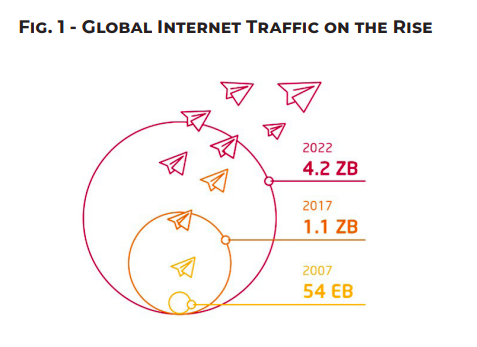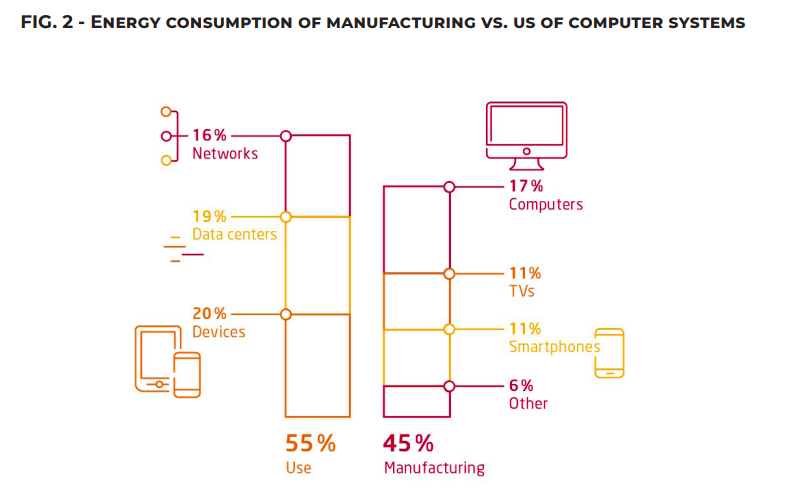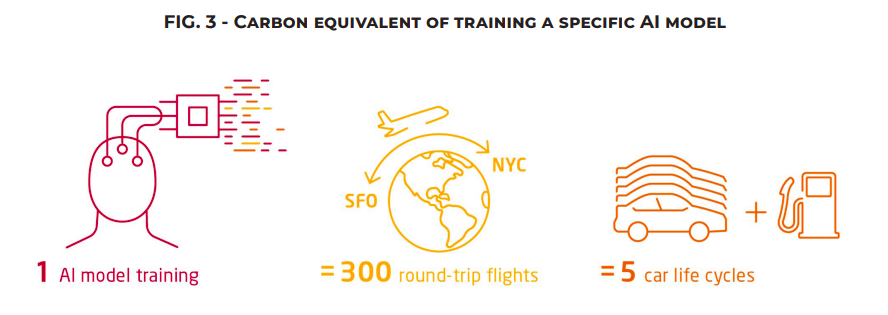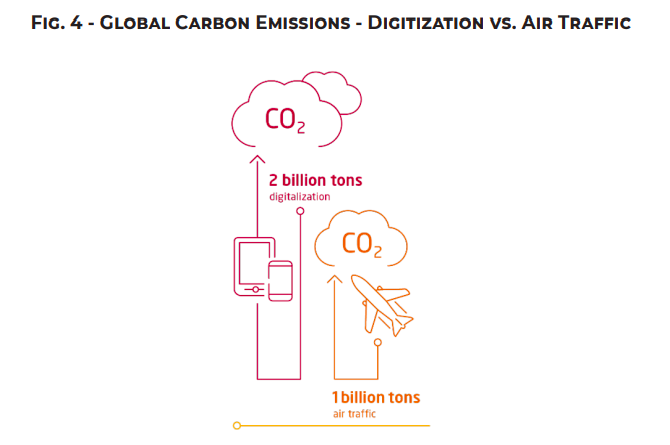Digital technologies are indispensable for achieving sustainable development goals and reducing carbon emissions in many sectors. Yet, computer systems themselves have an immense energy requirement for their countless devices, data centres, applications and global networks. With COVID-19, the shift to digital in living, learning and earning has raised the spectre of digital harms and brought us closer to the time when digitalisation will become an increasing social and climate hazard. Since digitalisation has many important benefits, the G20 can be the first to acknowledge the issue of its rising global footprint and take pioneering steps towards global agreements on effective actions to counter it. The G20 can lead international agreements on common standards to measure energy consumption and propose a global “clean-IT” label. Furthermore, global awareness campaigns for policy makers, and in education and research institutions must be initiated beginning with the G20 countries to increase funding for research activities in this urgently needed, yet barely recognised field. “Sustainability by Design” has to be the new paradigm in digital engineering education, research and application worldwide.
Challenge
CARBON FOOTPRINT OF DIGITAL TECHNOLOGIES RISES RAPIDLY
During the last decades, digital technologies were celebrated as the clean counterpart to old-fashioned “dirty” manufacturing, agriculture and energy production industries. It was believed that digital devices, products and services, due to their immaterial nature, do not contribute (or contribute very little) to global pollution by wasteful consumption of material resources and the emission of greenhouse gases. This belief is flawed. Digital devices and applications contribute significantly to the global carbon footprint. Even though neither computers, tablets and smartphones nor even data centres have chimneys, the amount of carbon emissions caused by digital technologies has become a threatening climate issue.
GLOBAL INTERNET TRAFFIC ON THE RISE
All data traffic requires energy. The total amount of annual internet traffic has risen exponentially during the last few years and continues to rise steeply. The International Energy Agency calculates that while in 2007 only 54 exabytes (54 billion gigabytes) of data were transferred over the internet, this amount increased by a factor of 20 in 2017 to 1.1 zettabytes (1,100 billion gigabytes). The same organisation estimates that annual data traffic will quadruple by 2022, reaching 4.2 zettabytes (IEA 2017).
RAPIDLY INCREASING SOFTWARE USE
A study of “The Shift Project” (2019) shows another interesting trend. Already in 2017, energy consumption in the use of digital technologies surpassed that of the production of digital devices by more than 5%, with a continuously rising share. This suggests that measures to decrease the carbon footprint of IT must focus on making digital technologies more energy efficient. We must pay attention to making IT usage more energy efficient as well as making the production of digital devices more resource efficient.

ENERGY CONSUMPTION OF THE LATEST DIGITAL INNOVATIONS
Researchers at the University of Massachusetts Amherst have studied the training life cycles of several common AI models and found that the energy consumption, and therefore the carbon emissions, of developing advanced neural networks are significant. The training of one specific AI model required about 300 tons of carbon dioxide equivalents, which equals the carbon emissions of the life cycle of five cars including fuel, or 300 round-trip flights from New York City to San Francisco (Strubell et al. 2019).

INEFFICIENT DIGITALISATION IS ABOUT TO BECOME A MAJOR CLIMATE HAZARD
Already today, the total carbon emissions of digital technologies surpass those of global air traffic by a factor of two. In 2019 all air traffic combined accounted for about one billion tons of carbon emissions and 2% of overall emissions (ATAG 2019). In the same year, digital technologies emitted about two billion tons, or about 4%, of all human-induced carbon dioxide (The Shift Project 2019). Humanity is at the beginning of a massive acceleration of digitalisation on a global scale. Currently the main polluters are energy production (42%), transportation (25%) and manufacturing (19%) (Statista 2018). Depending on the progress of additional renewable energy sources and steady growth in the energy requirements of digital technologies, it is not yet clear which of these trends will prevail. It is fair to assume that since the use of digital technologies requires more energy than production, that the current share of 4% will steadily rise as well and will eventually exceed the carbon emissions of transportation and manufacturing.

GREEN IT IS NOT ENOUGH
The issue of IT’s growing carbon footprint has been recognised for some time now and has led to various initiatives that can be summed up under the label “Green IT”. The primary focus of this movement is on the reduction of the waste of natural resources during the production and use of digital devices (OECD 2009), by using renewable energy sources and calling for “digital sobriety” (The Shift Project 2019). The US Environmental Protection Agency (EPA) and the EU Commission (in 2003) introduced the “Energy Star” label for energy-efficient ICT devices back in 1992. Despite this, the energy consumption of digital technologies continues to rise steeply. The testing schemes of the Energy Star label are not rigorous enough nor thorough enough. The increasing share of carbon emissions caused by the use of software and digital applications is not accounted for. Algorithmic efficiency is a major blind spot in most of the Green IT initiatives, which focus on physical device production, not on the daily emissions occurring over the life of the device and the software it runs. The rising footprint of digitalisation is not due to the increased use of digital technology during the COVID pandemic. COVID has merely accelerated the growth in digital carbon footprint, as data from the last decades coherently shows. Therefore, it cannot be expected that the carbon footprint of digitalisation will decrease after the pandemic. Certainly, the carbon emissions of digital technologies depend on the energy sources of their production and operation, and could be diminished by extensive use of renewable energy. However, there is not enough renewable energy available yet and it is also not reasonable to power inefficient computer systems with clean energy. We must design for sustainability, to use as little energy as possible. Otherwise, it would be like powering refrigerators from the 1950s with solar power and claiming that they are clean technologies: 70-year-old designs are more wasteful of energy than current refrigerators and using renewable energy alone would not make them clean.
Digital sobriety is also not likely to support the quest for a carbon-free planet. Even though technologies like energy-intensive AI and blockchain applications can be banned, as recently happened in China (Kharpal 2021), the appropriate reaction must be nuanced to foster sustainability and reduce digital harms. Digital technologies and innovative applications are essential to decreasing carbon emissions in other sectors like energy production, manufacturing and agriculture. Reducing the use of digital technologies in those sectors would increase total carbon emissions across all sectors. Digital technologies can achieve important goals, such as accelerating recovery from pandemics like COVID-19 and promoting lifelong learning and lifelong earning on a global scale. Digitalisation is the answer to many sustainability challenges. Therefore, we must invest in research and policy to achieve more energy-efficient digitalisation. This can only be done if digital engineering follows a novel paradigm, which we call “Sustainability by Design”. Devices must be designed properly up front and public and engineering awareness of the digital carbon footprint and especially of the impact of wasteful algorithms must be raised. Since the use of digital technologies already represents the biggest share of the digital carbon footprint and will continue to rise steeply it is necessary to design algorithms to use energy more efficiently. The trade-off between precision/speed/data throughput and energy consumption must be brought into balance by making it a core principle of computer system design.
Proposal
WHAT IS “CLEAN-IT” AND “SUSTAINABILITY BY DESIGN”?
With the introduction of digital applications to almost every imaginable aspect of human life, we can expect a dramatic increase in the use of digital technologies. At the beginning of the massive roll-out of such innovations, the repercussions of their use are barely tangible. However, examples from the past can guide us to not repeat our mistakes in applying new technologies.
When plastic was invented, it was a ground-breaking innovation in the field of new materials. A world without plastics would be less prosperous and innovations in many other areas would not have been possible. However, the increased use of plastics poses a threat to life on Earth today because of the high level of difficulty in recycling this material. Since the inception of the awareness campaign, less plastic is used and more importantly, more environmentally friendly and recyclable plastics have been invented. However, had the scientists and designers behind plastic development been mindful of its potential environmental impact from the onset, we would not be facing the massive (and very expensive) crisis of today.
Another example concerns the use of water in fountain systems. Early fountains used water without recycling, requiring a large reservoir at a high place to allow water to flow with sufficient pressure. The result was the gorgeous spectacles of beautiful fountains such as those in Versailles or the Summer Palace of Peter the Great near St. Petersburg. When electricity became available, with pumps and filters, the same water could be re-used, and water waste brought under control.
These two case studies reference the importance of following a design-led approach that promotes spending more time exploring the problem before rushing in with solutions. With digital systems and software specifically, it is very much the same: both are currently being designed in a manner that does not consider their environmental impact. Today, especially during the COVID-19 crisis, we are designing digital technology with a mindset similar to that prevalent in the designers of the first fountains in this case, not water but energy is used wastefully, or the object is wasteful in itself in the same way as plastics are. Ignorance of better methods unnecessarily increases our carbon footprint.
However, this is avoidable. Computer systems, which are based on the interrelationship of hardware and software, organised by algorithms, can be designed in different ways to produce the same outcome. Often unnecessarily complicated programming or computer system designs cause higher energy consumption when compared to algorithms that are more efficient. Innovative software architectures can achieve the same or only slightly lower precision or data throughput, while saving enormous amounts of energy. It matters how algorithms and computer systems are designed because every algorithmic operation consumes energy.
To solve the paradox of more from less, new design and algorithmic paradigms must be put into practice. The principle of “Sustainability by Design” needs to become the very foundation of the teaching and practice of digital engineering.
The principles of algorithmic efficiency and sustainability by design are best explained by tangible examples from current research in computer science:1
- Clean Data Profiling. Digital applications such as many new “smart” technologies require perfectly organised mass data sets. But the larger the data sets, the more time and thus the more energy is consumed for data profiling to make the data usable. To reduce the runtime of data profiling, researchers at HPI have developed the HPI-Valid algorithm. This reduces the runtime for a specific data profiling task from many weeks to a couple of seconds, saving an immense amount of energy (Birnick et al. 2020).
- Energy-Aware Computing. Data Centres are at the heart of digitalisation. Cloud applications, streaming, complex simulations everything runs in data centres. The ever-increasing energy consumption that results is a significant contributor to our global carbon footprint. Current research suggests that data centres can use heterogeneous computing resources to decrease the energy consumption of a computation task by a factor of 10 if the right computation problem is routed to the right computation resource (Plauth et al. 2020).
- Energy-efficient Deep Neural Networks. Deep Learning Neural Networks are a game changer in the field of Artificial Intelligence. However, deep learning algorithms consume a vast and constantly growing amount of energy during training and execution. Energy can be saved by lowering the complexity of AI models. By setting rounding data values in AI models, it is possible to sacrifice only 5% of precision, but to achieve about 95% of energy saving required for an AI computation (Bethge et al. 2019)
HOW CAN THE G20 IMPLEMENT POLICIES TO REDUCE THE CARBON FOOTPRINT OF DIGITALISATION?
Climate change is a threat that cannot be tackled by the efforts of single countries and single companies alone. It is a global phenomenon. In addition, the fact that digital technologies and services impact societies all over the world without regard to physical borders underscores the necessity for coordinated action.
Currently the USA and China, as digital “superpowers”, are the main contributors to the carbon footprint of digitalisation through their ubiquitous digital platforms and services. By introducing new computer systems for the global market, they effectively set the technological standards in cyberspace. Because of this, it is not sufficient for the G7 to deal with the issue of reducing the carbon footprint of digitalisation; a broader approach needs to be pursued which can only be led by the G20. It is obvious that political interests between the digital superpowers are not aligned, especially taking the “Great Firewall” into account.
However, the question of standards to reduce the energy consumption of algorithms is ideologically agnostic and not a matter of national security. Energy-efficient algorithms and digital architectures can be implemented without regard to national interests. On the contrary, energy-efficient computer systems are able to boost economic development as well as preserve the climate. Therefore, clean-IT could be an international topic and discussed by global competitors, generating benefits for all sides.
Furthermore, computer systems are increasingly created across developed countries. Standards for sustainable computer systems therefore need to be discussed and implemented globally. International institutions such as ITU and IEEE can be facilitators of measures to reduce the footprint of digitalisation. However, they do not have the power to enforce international agreements on education, research, innovation and environmental policy. The G20 therefore needs to make a coordinated effort to engage in policies to improve the energy efficiency of computer systems to contribute to the long-term low greenhouse gas strategies agreed upon at previous COPs.
Specifically, we make 4 proposals for policies to reduce the global carbon footprint of computer systems:
1. G20 member states should take up the issue of “sustainability by design” and the state of energy consumption of computer systems in their working group on “Energy Transition and Climate Sustainability” and operate regional networks of community digitalisation labs to assess the current state and the implementation of sustainable digital technologies. The permanent working group within the G20 summits should gather information on the topic and produce policy recommendations on how to reduce the carbon footprint of computer systems design and usage.
2. G20 member states should lead the way in establishing and coordinating incentives for research and public education in energy effective algorithms. Trade-offs in performance and energy consumption must be incorporated in the digital engineering curriculum. To this end international research centres for the assessment of the digital carbon footprint should be established to make informed decisions on economic, social, and environmental policy.
3. G20 member states should update their software procurement guidelines towards energy-efficient software solutions in a coordinated manner. The adoption of innovative technologies and novel societal paradigms needs to be supported by politics and public administration.
4. G20 member states should establish an internationally recognised clean-IT label for sustainable computer systems. Internationally recognised quality labels and standardisation can play a major role in promoting widespread awareness and penetration of sustainable software in public and private enterprises. Especially in computer systems, it is hard to distinguish whether products and services are sustainable due to heterogeneous hardware infrastructures, a mix of different software solutions and individual use of IT. Common standards therefore need to be put in place.
NOTES 1 A large collection of examples of clean-IT solutions in different domains of digitalisation can be found at the clean-IT Forum. open.hpi.de/channels/clean-it-forum
REFERENCES
Air Transport Action Group (ATAG), (2019) https://www.atag.org/facts-figures.html
Bethge J., H. Yang, M. Bornstein, and C. Meinel, (2019), BinaryDenseNet: Developing an Architecture for Binary Neural Networks, Computer Vision Foundation; https://openaccess.thecvf.com/menu
Birnick J. et al., (2020), Hasso Plattner Institut
International Energy Agency (IEA), (2017), DIGITALISATION AND ENERGY, Technology Report, November https://www.iea.org/reports/digitalisation-and-energy
Kharpal A., (2021), “Major bitcoin mining region in China sets tough penalties for cryptocurrency activities”, CNBC, 25 May https://www.cnbc.com/2021/05/26/major-china-bitcoin-mining-hub-lays-out-harsher-crackdown-measures.html
Organisation for Economic Co-operation and Development (OECD), (2009), Towards Green ICT Strategies: Assessing Policies and Programmes on ICT and the Environment, OECD, June https://www.oecd.org/internet/ieconomy/42825130.pdf
https://openaccess.thecvf.com/ (2020), “Improved data transfer efficiency for scale-out heterogeneous workloads using on-the-fly I/O link compression”, in Concurrency and Computation: Practice and Experience, John Wiley & Sons Ltd https://onlinelibrary.wiley.com/doi/10.1002/Institut
Statista (2018) https://de.statista.com/statistik/daten/studie/167957/umfrage/verteilung-der-co-emissionen-weltweit-nach-bereich/
Strubell E., et al., (2019), Energy and Policy Considerations for Deep Learning in NLP, College of Information and Computer Sciences University of Massachusetts Amherst https://arxiv.org/pdf/1906.02243.pdf
The Shift Project 2019, (2019), – Lean ICT – Towards Digital Sobriety, Report of the working group directed by Hugues Ferreboeuf for the think tank the shift project, March https://theshiftproject.org/wp-content/uploads/2019/03/Lean-ICT-Report_The-Shift-Project_2019.pdf








